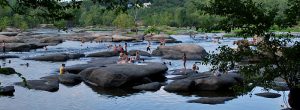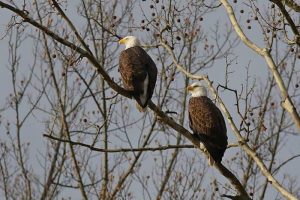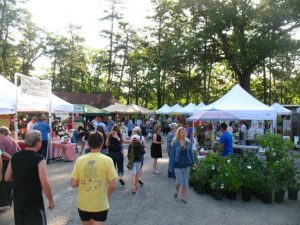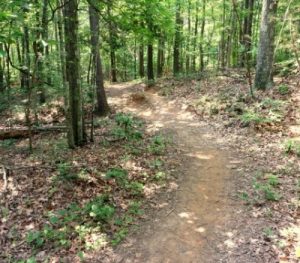Andrew, Parr, Heera, Jack and I stumbled out of my car and raced towards the rocks. It was a hot September day, and the sticky air suffocated us as we hurried to get in the water. We swam on our bellies, trying to avoid the treacherous rocks that surrounded us. We basked on the boulders protruding from the water, absorbing the sun. All around us, people were enjoying the chilled exhilarating water as it splashed up around them. Everyone was connected through their love of Pony Pasture, a truly magical place. Small fish were visible through the moving rapids, and I lazily tried to count them. As I stretched out on my rock, I could reflect on the importance of Pony Pasture, and of all parks as a whole. Parks not only provide an important environmental benefit to their surrounding communities, they also help bring people of a community together and provide individuals with a deep and meaningful connection with nature.
In a world of overwhelming concrete at every turn, where asphalt covers 2.7 million miles of paved roads[1] and where over half of the world has been modified and developed to fit our needs[2], public parks and green spaces act as an important environmental benefit. By setting aside beautiful natural areas and saving them from being developed, we are ensuring to maintain healthy parts of the environment. Parks are home to countless animal refugees fleeing the urbanization of their past habitat. I recall kayaking along the James river at Dutch Gap and seeing a mesmerizing bald eagle elegantly perched atop a tall snag. Maintaining natural areas is critical to these animals and the ecosystems as a whole. Furthermore, our parks can help protect water quality in a watershed. As our environmental negligence creeps over to our parks in the forms of heavy metals, offshore drilling, contaminated runoff from agricultural and urban sites, groundwater pumping, dams, and more, parks today are facing new pollution challenges that could impact their ecosystems and waterways[3]. We saw this first hand at Dutch Gap, where the conservation area is in sight of the Dominion Power Plant which releases warm effluent into the water. Jack’s wonderful post describes how Dutch Gap is home to a variety of wildlife, despite its industrial past and current challenges involving Dominion Power[4]. Fortunately, despite these influences, parks continue to have better water quality standards and provide important wildlife habitat. They also help with runoff in their respective watersheds. Mainly constructed of permeable surfaces, the natural landscape of parks can provide precipitation an opportunity to infiltrate the soil, helping to decrease runoff pollution and erosion into waterways. Altogether, parks are a great environmental sanctuary our ecosystems need.
Together, celebrating the great environmental impacts of parks, parks can also create community. When people gather to celebrate the James River Park system and watch short films on the floodwall, we can connect as humans who share an appreciation of the public spaces we share. When dancing together at the Richmond Folk Festival and exploring the banks of the James River, a sense of community grows beyond the constraints of localized regions, as Parr explained in his eloquent post[5]. I experienced how parks help foster community first-hand at Forest Hill Park. I attended the Richmond H2O Watershed Open House and saw a mirage of colorful posters and presentations all pushing for the implementation of Best Management Practices in regards to Richmond’s storm water system. Passionate people chose to gather at Forest Hill, knowing it would attract local residents and help foster a greater community drive to address Richmond’s runoff problems. Furthermore, I’ve attended the “South of the James” farmer’s market held at Forest Hill Park. Connecting over the love of local food and supporting neighborhood farms, the people in attendance were fostering a great sense of Richmond community together. Parks create community and creating community matters. A study performed by the American Journal of Epidemiology showed that the creation of parks nearby distressed neighborhoods in Philadelphia, Pennsylvania, decreased stress levels and obesity rates among individuals and also helped foster a greater shared sense of community[6]. Furthermore, as I addressed in my blog post about the Richmond Folk Festival, a sense of community drives people to care more about their community; this drive can, therefore, foster greater environmental protection and awareness[7].
I think my hometown has a pretty great sense of community, and that’s mainly due to our many parks. As a child, I went to city parks in Charlottesville all the time. Walking peaceful trails at Preddy Creek (my favorite park), sledding down the big hill at Washington Park on a snowy day, and having a picnic with my family at Penn Park are some of my most cherished memories. Being in nature from such an early age has helped to develop my passion for its protection. Today, through visiting so many parks and green spaces for our SSIR, my love of nature has only grown. Many people feel as though they are most at peace outside in nature, and parks provide an essential place for connection to nature to occur. When we look at the value of all nature, not just the “untouched sublime” wilderness we generally admire, we can experience a greater connection to the outdoors; furthermore, this drives a greater desire to protect all of our natural spaces, even the seemingly less extraordinary ones such as local parks[8].
As I relaxed atop the boulder in Pony Pasture park looking down into the rapids, I couldn’t help but reflect upon all of the many benefits public parks have for a community. Public parks have always been important to me, but this class has illuminated even more benefits I hadn’t previously considered. Maybe I’m being a little Leslie Knope here, but I think public parks are one of the most important things you could have in a neighborhood. Building community, encouraging connection to nature, and acting as an important natural ecosystem amongst our concrete world, parks acts as a necessary oasis from our urban environments. Through the services parks provide, they further encourage their own protection and the implementation of new parks.
“Thousands of tired, nerve-shaken, over-civilized people are beginning to find out that going to the mountains is going home; that wildness is a necessity; and that mountain parks and reservations are useful not only as fountains of timber and irrigating rivers, but as fountains of life.”
–John Muir
Sources:
[1] “Engineering Overview.” National Asphalt Pavement Association. N.p., n.d. Web.
[2] Hooke, R., and J. Martín-Duque. “Land Transformation by Humans: A Review.”GSA Today –. N.p., n.d. Web. 17 Oct. 2016.
[3] Pringle, C. “Threats to U.S. Public Lands from Cumulative Hydrologic Alterations Outside of Their Boundaries.” Ecological Applications 10.4 (2000): 971-89. Web. <https://blackboard.richmond.edu/bbcswebdav/pid-663711-dt-content-rid-1108322_1/courses/201610_16532/Pringle_Hydro%20Outside%20Park%20Boundaries_2000.pdf>.
[4] https://blog.richmond.edu/james/2016/10/13/a-wildlife-haven-and-industrial-wasteland-confusion-at-dutch-gap/
[5] https://blog.richmond.edu/james/2016/10/15/where-are-the-geographic-boundaries-of-community-drawn/
[6] Branas, C., Cheney, R., et. al. 2011. A Difference‐in‐Differences Analysis of Health, Safety, and Greening Vacant Urban Space. American Journal of Epidemiology. 174(11):1296‐306.
[7] https://blog.richmond.edu/james/2016/10/16/volunteering-at-the-richmond-folk-festival/
[8] Cronan, W. “The Trouble with Wilderness; Or, Getting Back to the Wrong Nature.” William Cronon. N.p., n.d. Web. 17 Oct. 2016.




